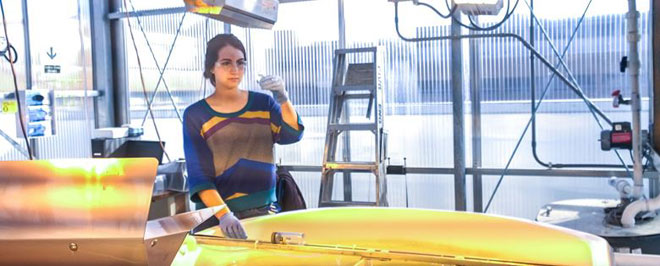
With a slimy green complexion and a name like Chlorella Kessleri, it conjures up the image of a cruel Disney villainess.
But the tiny algae plant, also known as Chlorella Vulgaris, is actually the real-life hero of a process being perfected by University of Kansas engineering students and faculty — a process that could not only help to improve the planet’s fresh water supply, but also be the source of a new alternative and environmentally friendly fuel.
Belinda Sturm, associate professor of civil, environmental, and architectural engineering, is one of the key researchers of KU’s Feedstock to Tailpipe Initiative. She and her colleagues are working with a team of about 25 KU graduate and undergraduate engineering students to turn the tiny water-based plants into biofuel.
“We remove nutrients like nitrogen and phosphorus that harm the environment and make a useful product,” Sturm said. “That’s the bottom line. We’re cleaning up wastewater and creating a biofuels feedstock.”
One of the goals of the KU project is to show how a city or county could grow its own algae to treat nutrient-rich wastewater. After the algae consume the nitrogen and phosphorus, the cleaner water can be returned to nature.
As a bonus, the municipality could send its own crop of microalgae to a facility that could convert it into biofuel for cars, trucks, trains, and even aircraft.
At KU, the process brings together three fields: civil and environmental engineering, chemical engineering, and mechanical engineers.
The first step is proving how the microalgae could be grown in a real-life facility.
Emily Cook, a senior majoring in civil engineering with an environmental emphasis, is on the team managing an algae-growing operation in a greenhouse on the roof of KU’s M2SEC research facility, part of the School of Engineering complex.
“We measure everything — sunlight, oxygen, carbon dioxide, the pH, how many nutrients we put in, the temperature, the saltiness of the water, conductivity,” Cook says. “A lot of things go into an algal growth model.”
The greenhouse has two 1,100-liter rectangular “raceway ponds” filled with a rich recipe of nutrients. Rotating metal paddles keep the algal biomass from settling to the bottom.
As the microalgae grow, the water turns from a pale to a deep green color. After about three weeks, the growth stops. The microalgae are pumped into a powerful centrifuge that spins out the water, leaving the green goopy biomass behind.
“We scrape the algae off the walls. It’s kind of a toothpaste consistency. It’s squishy. That’s what we freeze. Then we give it to the chemical engineers,” Cook says.
The chemical and petroleum engineering researchers dry the microalgae in a hydrothermal liquefaction process. Then the mechanical engineering team takes over, testing the biofuel in an engine for its performance and emissions.
“We’re finding that it produces a quality of fuel that is close to petroleum,” Sturm says. “We believe it’s unique and we’re excited about it.”
The initiative is funded by several federal grants from agencies including the Department of Energy, the National Science Foundation, and NASA.
Information provided by University of Kansas